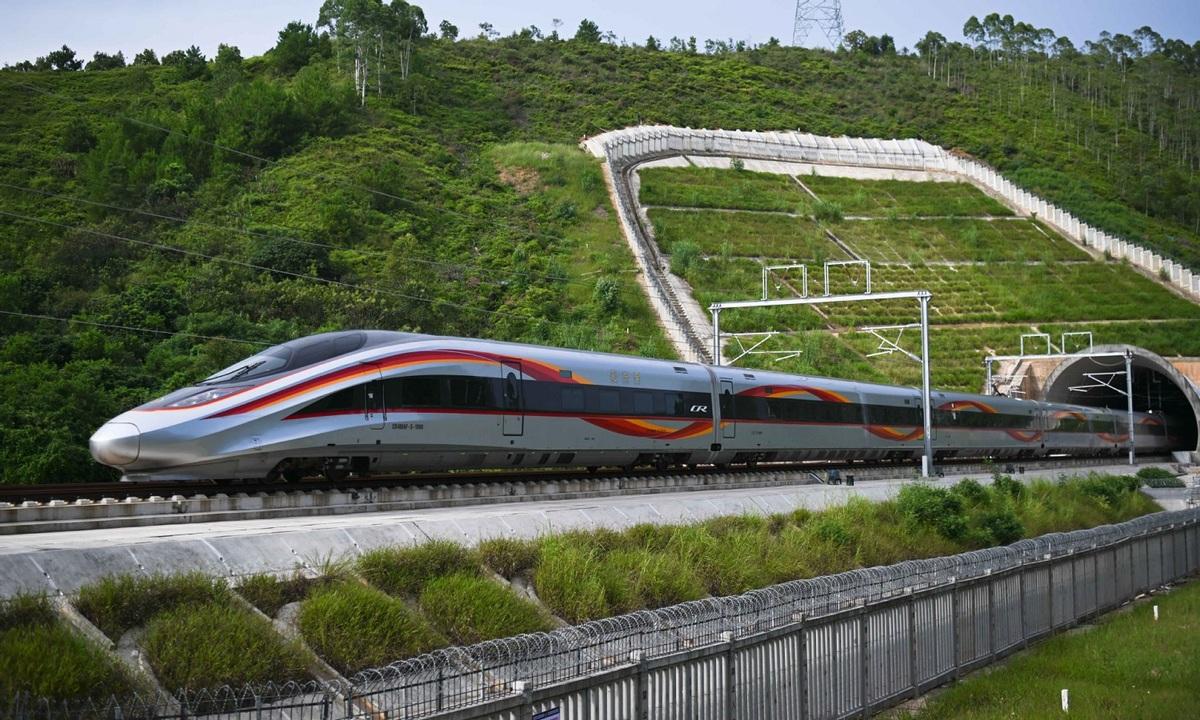
 0 Comment(s)
0 Comment(s) Print
Print E-mail China Daily, September 16, 2024
E-mail China Daily, September 16, 2024
This photo taken on Sept 13, 2024 shows an experimental high-speed train running along the Longyan-Longchuan High-Speed Railway in South China's Guangdong province. [Photo/Xinhua]
China's railway network has achieved a major milestone as of Saturday, surpassing 160,000 kilometers of operational track, including over 46,000 km of high-speed rail, China State Railway Group, the national railway operator, has announced. This positioned China with the world's largest high-speed railway network and also one of the most advanced globally, the group said.
The latest addition to the network is a high-speed rail line linking Meizhou city with Longchuan county in southern China's Guangdong province. The 94-km railway, which began operations on Saturday, has contributed to reaching this new milestone in the railway network development.
Since the end of 2012, China's railway infrastructure has seen substantial growth. The total length of the railway network has increased by 64.2 percent, while high-speed rail has expanded by an impressive 392.2 percent.
This expansion has established China's rail infrastructure as world-class, excelling in passenger and freight transport, technological innovation, energy efficiency and safety.
Over a century ago, Sun Yat-sen, a pioneering Chinese revolutionary leader, envisioned a modernized China in his book The International Development of China. His plan included the construction of 1.6 million km of roads and approximately 160,000 km of railways. Today, while Sun's vision for railways has become a reality, the development of China's high-speed rail has exceeded his expectations.
Since the Beijing-Tianjin High-Speed Railway opened in 2008, China has built the world's most extensive and advanced high-speed rail network. Major projects, such as the Guangzhou-Shenzhen-Hong Kong Express Rail Link and the Lhasa-Nyingchi Railway in Xizang autonomous region, have significantly enhanced connectivity and regional development.
Li Jingwei, deputy head of the development and reform department of the group, highlighted the accelerated pace of construction. "Since 2012, the expansion of China's high-speed rail has intensified, with an average of over 3,000 kilometers of new high-speed rail lines put into operation annually," Li said.
The country's high-speed rail network has now accounted for more than 70 percent of the world's total high-speed rail. Of this, lines operating at speeds of 300-350 km/h covered 20,000 km (43 percent), while lines operating at 200-250 km/h covered 26,000 km (57 percent).
Notably, China is the only country to achieve commercial operation of high-speed rail at 350 km/h, showcasing its technological prowess, he said.
"From snowy forests in the northern part of China to the water towns in the eastern region, and from the desert to the sea, China's high-speed rail traverses major rivers, rugged mountains and connects all regions," Li said.
He also said that the high-speed railway network now covered 96 percent of cities with populations over 500,000, including the Hong Kong Special Administrative Region.
China's high-speed railway has played a crucial role in the country's economic and social development, reducing travel time and boosting industrial development along the routes, he said.
"The travel time between Beijing and Shanghai has been reduced from around 12 hours to just over 4 hours, while the journey from Beijing to Guangzhou (in Guangdong province) has been cut from about 21 hours to over 7 hours. This transformation has revolutionized the way Chinese people travel and many people have enjoyed traveling by bullet trains," Li said.
Go to Forum >>0 Comment(s)